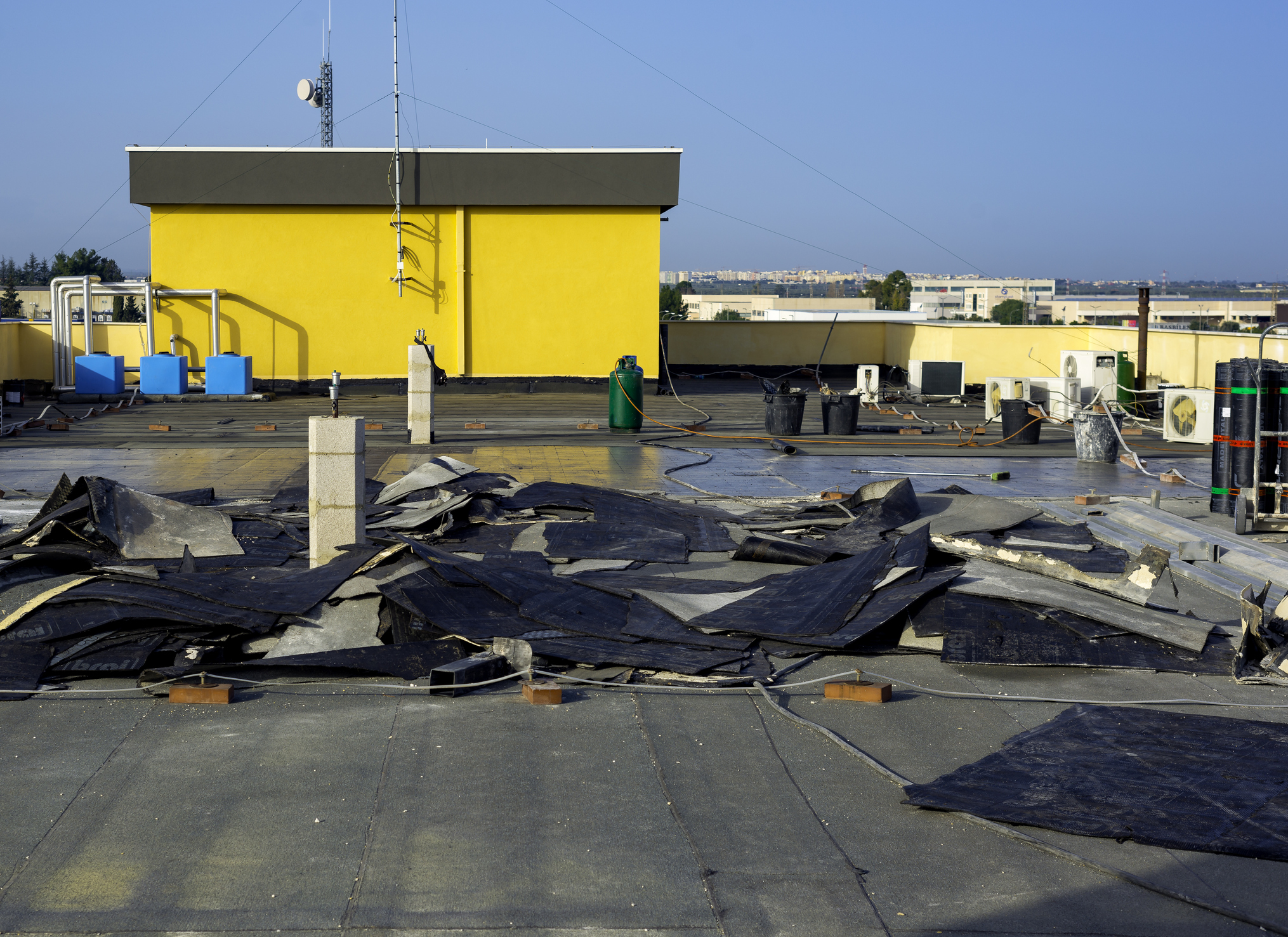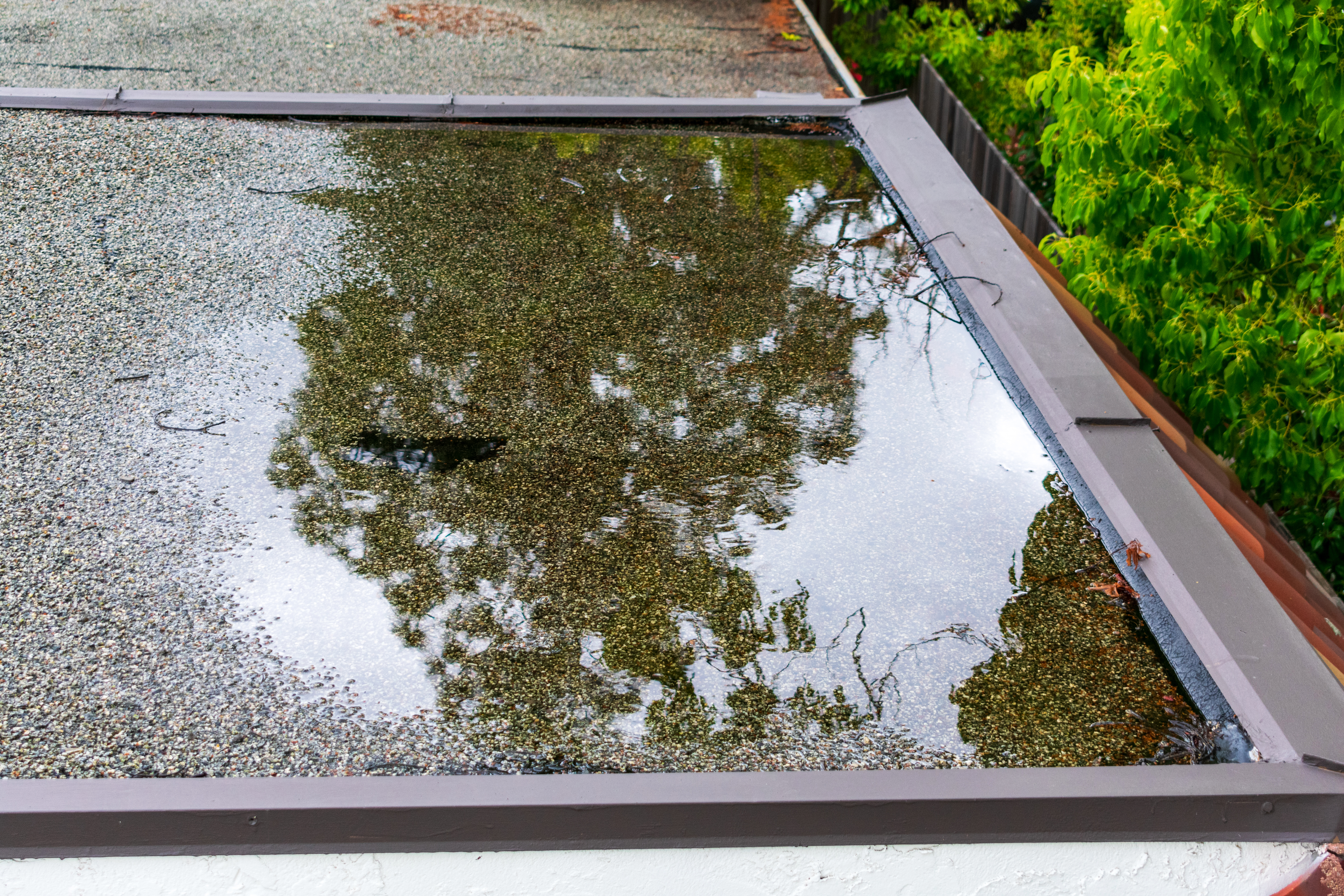Recognizing the Opportunities for Restoration
Mod-bit roofing consists of a reinforced bitumen membrane modified with polymers for enhanced performance. The primary component of mod-bit roofing is the bitumen membrane, which provides waterproofing and weatherproofing properties. This type of roofing provides an effective solution for flat or low-slope roofs, combining the benefits of BUR with improved performance and ease of installation. And while BUR/mod-bit systems are durable, they have their own vulnerabilities.
Blistering is a common issue with mod-bit roofing and occurs when air or moisture becomes trapped between the layers of the membrane. It can be caused by improper installation, inadequate substrate preparation, or excessive heat during application. Blistering can lead to membrane delamination, reduced waterproofing effectiveness, and potential leaks.
Mod-bit roofing membranes have seams where the individual rolls or sheets are joined together. If the seams are not properly installed, sealed, or maintained, they can be prone to failure. Common seam issues include open or poorly adhered seams, separation, or seam disintegration, which can result in water infiltration and leaks.
Another issue is “alligatoring” or cracking, which refers to the formation of a pattern of small cracks on the surface of the mod-bit membrane. It can be caused by age, weathering, or exposure to UV radiation. Cracking can compromise the integrity of the membrane, leading to water penetration and reduced performance.
Ponding water occurs when water accumulates and remains stagnant on the roof surface for an extended period, typically due to inadequate drainage or improper roof slope. Mod-bit roofing systems should be designed to prevent ponding water, as it can lead to membrane deterioration, accelerated aging, and potential leaks. But over time, ponding can occur on even the best-designed surfaces.
Mod-bit roofing membranes can be vulnerable to damage from foot traffic, falling debris, or sharp objects. Punctures, tears, cuts, or abrasions in the membrane can compromise the waterproofing properties of the roof, leading to leaks and potential structural damage.
As with other roofing systems, BUR and mod-bit flashings can become a point of failure. Improperly installed or deteriorated flashings can result in water penetration, compromising the roof’s integrity and causing leaks. In general, improper installation practices can result in a range of issues with mod-bit roofing systems that lead to poor adhesion, weak seams, or compromised waterproofing.
The Four Rs: Repair, Restoration, Recover, Reroof

Restoration can be an easier and more cost-effective way to prolong the life of a roof, but it requires that the original roof is in reasonable condition.
There are different approaches to addressing issues or maintaining a roof’s condition. Factors such as the extent of damage, roof age, budget, and long-term goals will influence the decision between repair, restoration, recover, or reroofing.
Repair Pros and Cons
Roof repair involves fixing specific issues or damage to restore functionality and integrity of a roof. Repairs are typically focused on addressing localized problems, such as leaks, punctures, or flashing issues. Repairs are carried out on a case-by-case basis, targeting the specific areas that require attention. The purpose of repair is to fix the problem and prevent further damage—without necessarily replacing the entire roof. Repair is effective for immediate issues, offers a low-cost option, and can help solve an individual issue in a fairly non-invasive way. The downside is that repairs don’t address any larger issues with a roof, only serving as a bandaid.
Today’s bituminous roofs are ideal for repair because original waterproofing bitumen is easily bonded to new modified repair mastics and coating materials. Additionally, standardized repair procedures have been perfected—following established best practices can return an original roof to peak performance. However, replacement may be a necessity in certain situations, depending on the overall condition of the roof.
Restoration Pros and Cons
Roof restoration is a more comprehensive process than repair and involves rejuvenating an aging or deteriorated roof to extend its lifespan. Restoration typically involves cleaning the roof, repairing any damage, and applying a specialized coating system to enhance the roof’s performance. This approach is commonly used for flat or low-slope roofs and can provide added protection against UV radiation, weathering, and leaks. Restoration is the most cost-effective, least disruptive, and most minimally invasive way to address the entire roof. It also provides an environmentally friendly approach because it prolongs roof life. Restoration is an approach that provides comprehensive repairs and reflective coating for the entire system. Finally, restoration comes with long-term warranties. When considering restoration, however, it must be with a good roof that is in reasonable condition. A highly degraded roof is not a viable candidate for restoration. In addition, restoration may not always be cost-effective, which is why evaluation is important.
Recover Pros and Cons
Recover refers to installing a new roof layer over the existing roof surface. It involves adding a new layer of roofing material on top of the old roof, providing an additional protective barrier. Recover is typically done when the existing roof is structurally sound, but its outer layer has deteriorated or reached the end of its lifespan. The recover process can save time and cost compared to a complete roof replacement, as it eliminates the need to remove the existing roof. For this reason, too, it is more environmentally friendly than a full reroof. As with restoration, recovers provide a fully reflective roofing system that repairs can’t achieve, but at a lower cost than reroofing—though it should be noted that some of the KEE formulas do tan out, and if roofs are not properly maintained the reflective element will degrade. Like restoration, recovers come with long-term warranties—anywhere from 10 to 20 years. On the downside, a recover can only be done once. Once you do a recover on a roof, that is your second layer and the National Roofing Code won’t allow for another layer on top of the recover. Just as with restoration, recovers can only be done with roofs that are in good condition, otherwise the system will fail prematurely.
The weight of the roof must also be considered when recovering, because the additional weight of the new roofing materials can put stress on the underlying structure of the building. The structural capacity of the building is designed to support a certain amount of weight, including the original roof load. In addition, if there are pre-existing structural deficiencies in the building, such as weak or deteriorated roof trusses, compromised walls, or inadequate support systems, adding more weight through recovering can exacerbate these issues. Building codes and regulations set specific guidelines regarding the maximum weight that a building’s structure can support. Compliance with building codes is essential to ensure the safety and integrity of the structure. Depending on what is already there, layers of roof or gravel may need to come off to help with weight issues.
Reroofing Pros and Cons
Reroofing involves completely replacing an existing roof system with a new one. It includes removing the old roof layers down to the roof deck and installing a new roof covering. Reroofing is necessary when the existing roof has extensive damage, is structurally compromised, or has reached the end of its lifespan. It provides the opportunity to upgrade the roofing system, improve insulation, or change a roof’s design. There are definite advantages to reroofing. Reroofing removes a bad roof from the deck up, which allows you to evaluate the entire roof deck surface. And because it is a new system, a reroof brings everything up to current code and provides a brand-new warranty. On the downside, reroofing requires careful planning and is typically more expensive and time-consuming than recovering or repairs. It is not as environmentally friendly, because all the material from the old roof is being put in a landfill and new material is being used—which will also, eventually, end up in the landfill. It is the most invasive solution and poses the most liability for contractors during installation since whole sections of the roof will be open and exposed.
Section 2: How Do You Decide?
Assessing

Ponding water is a detail easily identified during a visual assessment, and which could indicate structural sagging in the deck.
Assessing the condition of a roof is crucial when making decisions about whether to repair, restore, recover, or reroof. A visual inspection is a basic and initial assessment method. Initially, this will involve clearing off any trash or accumulated debris that might inhibit a complete visual inspection. Fully vacuuming dirt and gravel from the roof’s surface will grant an even clearer picture. From there, some clues may become easily apparent to the naked eye:
- A soft area underfoot is an indicator of saturated insulation.
- Rusted, rotted, or cracked decking can sometimes be seen from the inside of the building and may help locate the worst areas of deck deterioration.
- Ponding water could indicate structural sagging in the deck.
- A splitting membrane may be visible to the naked eye for experienced professionals.









